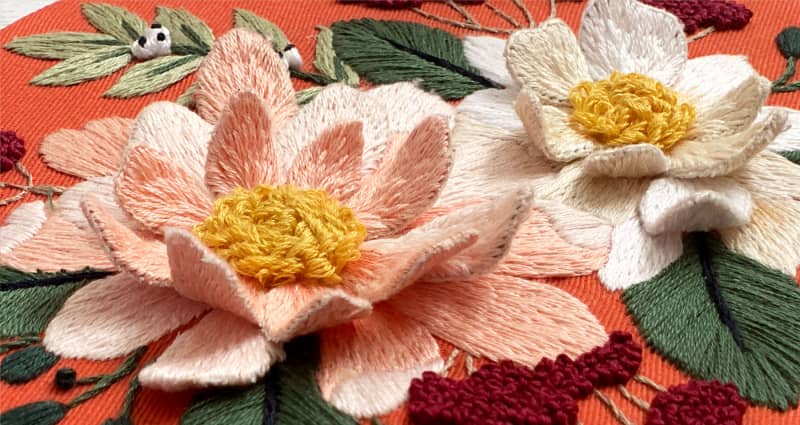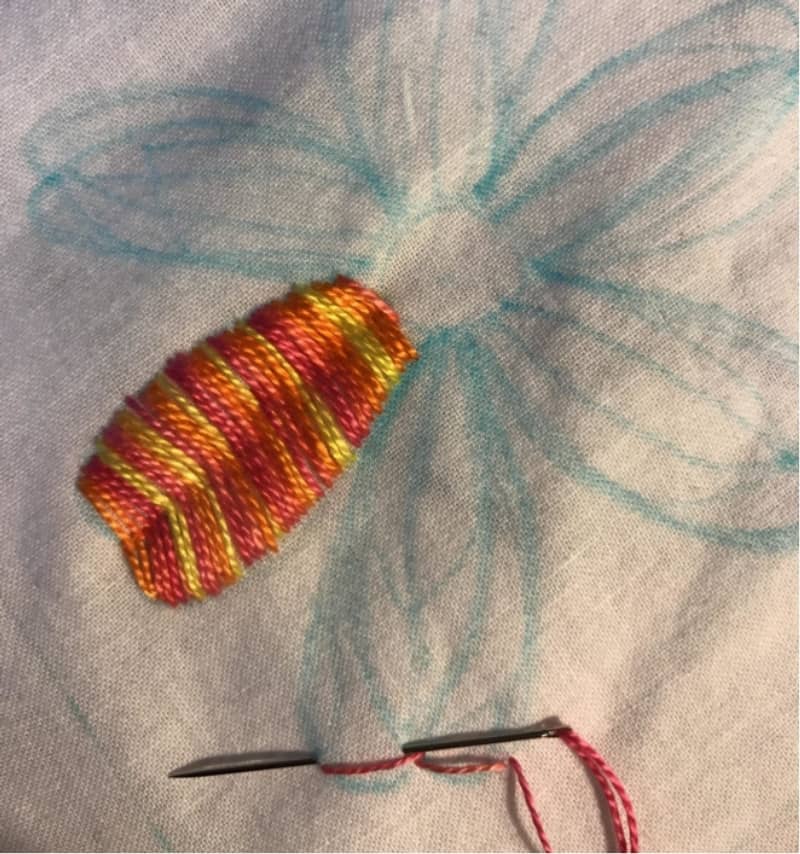Introduction
Embroidery is an ancient craft that has been practiced for centuries. It involves using thread or yarn to create designs on fabric or other materials. Over the years, embroidery techniques have evolved and expanded, leading to the development of various types of embroidery, including 3D embroidery and flat embroidery. In this article, we will explore these two techniques in detail, highlighting their similarities and differences, as well as their respective advantages and disadvantages, and the types of projects they are best suited for.
1.3D Embroidery
3D embroidery is a technique that creates a three-dimensional effect on fabric by using a special type of embroidery thread or yarn. It is achieved by using a special type of thread called "purl thread" or "chenille thread" which is thicker and more opaque than regular embroidery thread. The thread is stitched in a way that creates raised areas on the fabric, giving the appearance of 3D.

(1) Advantages of 3D Embroidery
Dimensional Effect: The most obvious advantage of 3D embroidery is the dimensional effect it creates. The raised areas stand out against the fabric, making the design more visually appealing and giving it a tactile quality.
Durability: The thicker thread used in 3D embroidery makes the design more durable and long-lasting, ensuring that it remains intact even after multiple washes.
Embellishment: 3D embroidery is often used to add embellishments to clothing, accessories, and home decor items. It can be used to create flowers, leaves, and other intricate designs that add a touch of elegance and sophistication to the item.
Visual Appeal: The 3D effect adds depth and dimension to the design, making it more eye-catching and visually appealing.
Texture: The raised effect of the embroidery adds a tactile quality to the fabric, giving it a more luxurious feel.
Versatility: Can be used on various fabrics and materials, including synthetics, naturals, and blends.
Customization: The 3D effect allows for greater design flexibility, enabling creators to produce unique and custom designs.
Branding: Effective for branding and marketing as the 3D effect makes the logo or design more memorable.
(2) Disadvantages of 3D Embroidery
Limited Use: 3D embroidery is not suitable for all types of projects. It is best suited for designs that have a raised effect, and may not be appropriate for projects that require a flat, smooth finish.
Complexity: The technique of 3D embroidery is more complex than flat embroidery and requires more skill and experience. Novices may find it challenging to achieve the desired effect.
Cost: The materials used in 3D embroidery are often more expensive, and the process may require specialized equipment, , which may increase the overall cost of the project.
Maintenance: The raised design can be more difficult to clean and maintain, as dirt and lint can accumulate in the textured areas.
Bulkiness: The 3D effect can make the fabric bulkier and less flexible, which may not be suitable for some applications.
Limited Use: The 3D effect may not be suitable for all types of designs, as some may be too intricate or detailed to be effectively rendered in 3D.
(3) Projects Suitable for 3D Embroidery
Clothing: 3D embroidery is often used to add embellishments to clothing such as jackets, vests, and scarves.
Accessories: It can also be used to decorate accessories like bags, belts, and shoes.
Home Decor: 3D embroidery is suitable for adding a touch of elegance to home decor items like pillow covers, curtains, and tablecloths.
2.Flat Embroidery
Flat embroidery, also known as "regular embroidery" or "canvas embroidery," is the most common type of embroidery. It is a technique where the embroidery thread or yarn lies flat on the fabric surface, creating a smooth and even design. It is created by using a single thread to stitch designs onto fabric. The stitches are flat and do not create a raised effect like 3D embroidery.

(1)Advantages of Flat Embroidery
Versatility: Flat embroidery is suitable for a wide range of projects, including clothing, accessories, and home decor items. Its flat, smooth finish makes it appropriate for a variety of design styles.
Simple and Quick: The technique of flat embroidery is relatively simple and can be completed quickly, even by beginners. This makes it an excellent choice for those who are new to embroidery or who are looking for a fast, easy project.
Cost-effective: Flat embroidery is generally more cost-effective than 3D embroidery, as it uses regular embroidery thread and does not require any additional materials. The materials used in flat embroidery are generally less expensive than those used in 3D embroidery, resulting in lower production costs.
Easy Maintenance: The flat design is easier to clean and maintain, as dirt and lint are less likely to accumulate.
Good for Fine Details: Flat embroidery is better suited for intricate and detailed designs, as the thread lies flat and can easily follow the contours of the design.
Consistency: The flat nature of the embroidery allows for a more consistent and uniform appearance across the fabric.
(2)Disadvantages of Flat Embroidery
Limited Dimensional Effect: Compared to 3D embroidery, flat embroidery may lack visual depth and dimension, making it less eye-catching.
No Tactile Effect: The flat design does not provide the tactile sensation or texture that 3D embroidery offers.
Less Durable: The thinner thread used in flat embroidery can be less durable than the thicker thread used in 3D embroidery.
Design Limitations: Some designs may be better suited for the 3D effect and may not look as appealing when rendered in flat embroidery.
Monotonous: The flat nature of the embroidery can make the design appear monotonous and lackluster, especially for larger areas.
(3)Projects Suitable for Flat Embroidery
Clothing: Flat embroidery is commonly used for clothing items like shirts, jackets, and pants.
Accessories: It is also suitable for decorating accessories like bags, hats, and scarves.
Home Decor: Flat embroidery can be used for home decor items like pillow covers, curtains, and tablecloths.
3.Similarities between 3D Embroidery and Flat Embroidery
(1)Basic Principle
Both 3D embroidery and flat embroidery involve using thread to create designs on fabric. They both require a needle, thread, and a fabric surface to work on.
(2)Use of Embroidery Thread
Both types of embroidery use embroidery thread, which is a thin, colorful thread made from various materials such as cotton, polyester, or silk. The thread is used to create the designs by stitching it onto the fabric.
Design Transfer
Before starting the embroidery process, a design must be transferred onto the fabric. This can be done using various methods such as tracing, stencil, or iron-on transfer paper. Both 3D and flat embroidery require this step to ensure accurate placement and execution of the design.
(3)Basic Embroidery Stitches
Both 3D and flat embroidery use a variety of basic embroidery stitches such as the straight stitch, backstitch, chain stitch, and french knot. These stitches are the foundation of embroidery and are used in both types of embroidery to create the desired design.
4.Differences between 3D Embroidery and Flat Embroidery
(1)Dimensional Effect
The most significant difference between 3D embroidery and flat embroidery is the dimensional effect they create. 3D embroidery uses a thicker, more opaque thread called "purl thread" or "chenille thread" to create raised areas on the fabric, giving a three-dimensional appearance. On the other hand, flat embroidery creates a flat, smooth finish with a single thread, without any raised effect.
Technique and Difficulty Level
The technique used in 3D embroidery is more complex than flat embroidery. It requires skill and experience to create the desired dimensional effect. Flat embroidery, on the other hand, is relatively simple and easier to learn, making it a more suitable choice for beginners.
(2)Use of Thread
The type of thread used in 3D and flat embroidery differs. As mentioned earlier, 3D embroidery uses a thicker, more opaque thread, while flat embroidery uses a regular, thin embroidery thread.
(3)Projects and Applications
The choice of embroidery technique often depends on the type of project and its intended application. 3D embroidery is suitable for projects that require a dimensional effect, such as clothing embellishments, accessories, and home decor items. Flat embroidery, with its flat, smooth finish, is more versatile and can be used for a wider range of projects, including clothing, accessories, and home decor items that do not require a raised effect.
(4)Cost
The cost of embroidery can vary depending on the technique used. Generally, 3D embroidery can be more expensive than flat embroidery, as it requires specialized thread and may involve more labor. However, the cost can vary depending on factors such as the size of the design, the type of fabric, and the complexity of the design.
Conclusion
Both 3D embroidery and flat embroidery have their own unique characteristics, advantages, and disadvantages. 3D embroidery is best suited for projects that require a dimensional effect, while flat embroidery is more versatile and cost-effective for a wide range of projects.The choice of technique depends on factors such as the desired dimensional effect, the complexity of the design, and the intended application of the project. Understanding the similarities and differences between these two techniques can help embroiderers make informed decisions when choosing the appropriate technique for their projects.
Post time: Dec-05-2023





